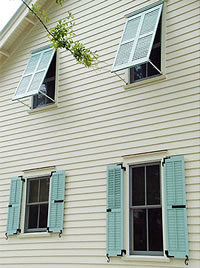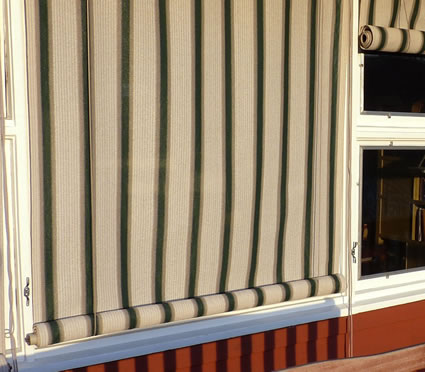Exterior Roller Shade
This article has details for exterior roller shades but also for exterior louvered and roller shutters.
Fabric selection and color can have a significant impact on visual and thermal performance of roller shades.
Exterior roller shades can be automated (motors, sensors, remote controls with a big impact on both performance and cost. For more details on automation, see our window covering automation fact sheet.
Description
Exterior shades and shutters are window coverings deployed on the outside of a building to dramatically reduce unwanted heat from the sun (solar heat gain). This is a high priority in hot climates or in any home where solar heat gain contributes to discomfort or significant air-conditioning costs. Exterior shades and shutters also provide a high degree of privacy; shutters may offer the added benefits of security and storm protection. By blocking solar radiation outside of the windows, exterior shades and shutters far more effectively reduce solar heat gain than interior blinds and shades. Exterior shades and shutters must be deployed to reduce heat gain and retracted or taken down as weather and space conditioning indicates to get the best energy savings.
Exterior Roller Shades
Exterior window shades are typically a fabric screening — usually polyvinyl chloride-coated polyester or fiberglass — that rolls up into a protected valance at the top of the window (or terrace door). Window shades have an openness factor that represents the ratio of openings in the fabric to the overall area. Typical openness factors for exterior window shades range from 3% to 30%. Even a fabric with a very low openness factor, say 5%, still provides fairly good visibility through the window from indoors if the fabric is partially transparent. Solar heat gain through exterior roller shades depends on the openness (the larger the openness factor, the larger the solar gain) but also on the transparency of the fabric itself. Roller shades are most commonly lowered or raised by hand; some are operated from the outside, and others can be operated from inside using a through-the-wall crank. The shade frames are typically anchored in place, but some low-cost systems attach manually using suction cups, Velcro, or snap systems.
Exterior Roller Shutters
Exterior roller shutters have hollow or foam-filled interlocking aluminum or plastic slats that form a fairly rigid protective barrier over a window when deployed and roll up neatly into a valance at the top of the window (or terrace door) when not in use. The slats typically fit into edge tracks and provide full privacy and security against break-ins and storms. Common in some areas of Europe, exterior roller shutters are less common in the U.S. although they are used in the southwest and hurricane-prone areas.
Exterior roller shutters can be lowered and raised manually or by a motor. Motorized operation can be fully automated (integrated into an energy management system) or controlled by the homeowner, often with a hand-held remote. Automated operation can be based on sunlight, temperature sensors, or a timer.
Exterior Hinged Shutters
Exterior hinged shutters are typically made of either wood or vinyl. Exterior shutters are common as non-functional decorative attachments. To provide benefits such as shading, privacy, and storm protection, shutters must be hinged and operable. Most hinged shutters have fixed horizontal louvers but adjustable louvers are also available and allow for more versatile shading control.

This image shows top-hinged 'bahama' shutters (2nd floor) and side-hinged 'plantation shutters (1st floor). Both types are decorative and functional, the former for shade and storm protection, the latter for decoration and storm protection.
Photo: Decorative Shutters
Overall Thermal Performance
The shade or shutter construction material and openness factor determine its effectiveness at blocking solar heat gain. Most common shades and shutters have fairly low solar heat gain when fully closed. The contribution of exterior shutters and shades to thermal insulation is less well understood but is less than can be achieved by exterior storm windows or interior window panels. Exterior shutters and shades provide a modest benefit in reducing wintertime condensation potential.
Key Benefits
- Reduce solar gain through windows
- Increase thermal comfort
- Reduce glare
- Protect existing windows
- Increase security (roller shutters)
- Protect against storm damage (roller and hinged shutters)
- Protect against fire in wildfire-prone areas (roller shutters)
Key Drawbacks
- Require manual operation, unless automated
- Expensive (roller shutters, particularly motorized and automated)
- Can be damaged by wind, ultraviolet radiation, etc. (more an issue with screen shades)
- Block view and daylight when deployed (more an issue with shutters than shades)
Aesthetics
- When deployed, change home’s appearance dramatically
Tips/Cautions
- When local approval is required for these window treatments, seek a designer’s expertise in optimizing the aesthetics or general appeal.
- If installing manual interior cranks for exterior shades or roller shutters, perform careful air sealing where cranks penetrate exterior wall.

This exterior roller shade is operated manually to control glare and solar heat gain, particularly in the summer (the home is located in New England).
Photo : BuildingGreen
When To Consider
Exterior Window Shades
- There is unwanted solar gain through windows.
- Shading, view, and ventilation are desired.
Exterior Roller Shutters
- Security is a high priority.
- Storm protection is a priority.
Shutters Are:
- Higher priority in climates with high air-conditioning loads.
- Most effective in sunny climates where more concentrated sunlight enters through windows.
When to consider this retrofit—Ownership
| x | Homeowner |
| Apartment Renter – Long Term | |
| Apartment Renter – Short Term | |
| Live in a Condo* | |
| Live in a Historical District* |
* May be prohibited by condominium associations or historical codes
When to consider this retrofit—Window conditions
| x | Existing window single-glazed |
| x | Existing window double-glazed, no low-e* |
| Existing window double-glazed with low-e (non-low-e films) |
* low-emissivity coating
Recommended Installer
| x | Do it Yourself* |
| x | Contractor |
| x | Manufacturer or supplier |
* For non-roller screens that attach with suction cups, Velcro, or snaps.
Complementary Options
- Interior storm windows for increased thermal resistance
Operation
| x | Motorized |
| x | Sensor |
| x | Manual |
Considerations
| 1 | 2 | 3 | 4 | 5 | |
| Ease of Installation (1 = easier) |
x | x | x | x | |
| Availability (1 = more available) |
x | x | x | ||
| Cost Details (1= lower cost) |
x | x | x |
Average Total Cost for 30- by 60-inch window
| Economy, manually-operated roller shade | $25 |
| Custom, motorized roller shade | $375 |
Digging Deeper
Energy Modeling Tools for Professionals
| RESFEN | |
| x | EnergyPlus-based modeling tools |
| x | WINDOW 6 |
| Other |
Resources
“Guidelines for Effective Residential Solar Shading Devices”
"The Impact on Energy Use and Peak Demand of Awnings and Roller Shades in Residential Buildings"
